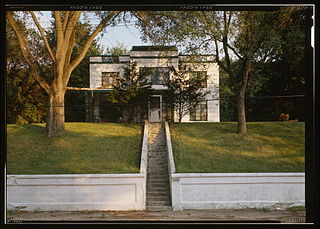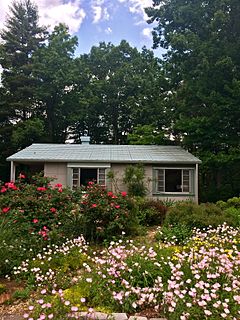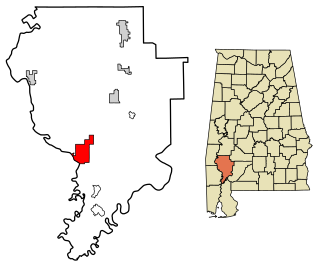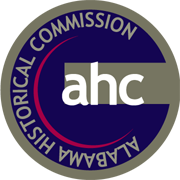
Lustron houses are prefabricated enameled steel houses developed in the post-World War II era United States in response to the shortage of homes for returning GIs by Chicago industrialist and inventor Carl Strandlund. Considered low-maintenance and extremely durable, they were expected to attract modern families who might not have the time or interest in repairing and painting conventional wood and plaster houses.

The Armco-Ferro House, in Beverly Shores, Indiana, was originally constructed for the 1933 Century of Progress Exposition in Chicago. "The ... Exposition opened in May of 1933 directed by the theme of science and its role in industrial advancement. Within the Home and Industrial Arts Group were model houses, which featured modern materials, building methods and innovative home appliances, including the Armco-Ferro-Mayflower, Wieboldt-Rostone and Florida Tropical houses, and the House of Tomorrow. All utilized new techniques of design, construction and prefabrication in an attempt to bring the out-of-date housing industry in line with more efficient manufacturing practices such as those used by the auto industry." The Home and Industrial Arts Group was the most successful venue of the Exposition. The Armco-Ferro House was designed by Robert Smith, Jr., of Cleveland, Ohio. It is the only remaining example from the exposition that met the Fair Committee's design criteria; a house that could be mass-produced and was affordable for an American family of modest means..
From research completed by the Historic American Buildings Survey (HABS): The Ferro Enamel Corporation, one of the two major sponsors for the ... house, was formed in 1930 by a merger between the Ferro Enameling Company and the Ferro Enamel and Supply Co. The idea of using porcelain enamel for residential construction was introduced by Bob Weaver, president of the newly formed company. Shortly after the merger, Charles Bacon Rowley, architect, designed a four-person house with Ferro-Enamel shingles that the company erected in Cleveland, Ohio, in July 1932.31 Despite the innovative use of ferroenamel as a cladding material, the house was built using conventional wood construction. The first porcelain-enameled frameless steel house was completed ... in South Euclid, Ohio ... Like the Armco-Ferro house, this house was designed by Robert Smith, Jr., and was built by Insulated Steel Corporation; ...
In 1932, the American Rolling Mill Company (Armco) ... built a second porcelainenameled frameless steel house ... using Robert Smith, Jr. as architect. The Ferro Enamel Corporation and the Insulated Steel Construction Company collaborated with Armco, thus setting the stage for the partnership that made the Century of Progress home possible.

The Patterson House in Larned, Kansas is a three-bedroom Lustron house built in 1949. Together with its matching Lustron garage, it was listed on the National Register of Historic Places in 2001.

The Lustron Houses of Jermain Street Historic District is located along that street in Albany, New York, United States. It consists of five prefabricated homes built by the Lustron Corporation after World War II. It was recognized as a historic district and listed on the National Register of Historic Places in 2009.

The Bishop Family Lustron House is a historic Lustron house located at 26 Slater Drive in Glenville, Schenectady County, New York.

The J. P. McKee Lustron House is a historic enameled steel prefabricated house in Jackson, Alabama. Designed and constructed by the Lustron Corporation, this example is one of two in Jackson. The other, the Doit W. McClellan Lustron House, is just around the corner from the McKee Lustron.

Roy Blass was an American architect whose work included design of Lustron houses.

The John D. and Katherine Gleissner Lustron House is a historic enameled steel prefabricated house in Birmingham, Alabama. Designed and constructed by the Lustron Corporation, this example is one of three confirmed to have been built in Birmingham. Another, the Bernice L. Wright Lustron House, is just one house over from the Gleissner Lustron House.

The Bernice L. Wright Lustron House is a historic enameled steel prefabricated house in Birmingham, Alabama. Designed and constructed by the Lustron Corporation, this example is one of three confirmed to have been built in Birmingham. Another, the John D. and Katherine Gleissner Lustron House, is just one house over from the Wright Lustron House.

The Lustron Home No. 02102 is an historic enameled steel prefabricated Lustron house located in Cedar Rapids, Iowa. It was listed on the National Register of Historic Places in 2004.

The Neville and Helen Farmer Lustron House is a historic enameled steel prefabricated Lustron house in Decatur, Georgia. Designed and constructed by the Lustron Corporation, this example is one of two confirmed to have been built in Decatur.

Bruce A. and June L. Elmore Lustron House is a historic home located at Asheville, Buncombe County, North Carolina. It was built in 1949, and is a one-story, side-gable-roof Westchester Deluxe two- bedroom-model Lustron house. It is sheathed in dove grey and green enamel-finish steel panels. An addition was made to the house about 1985.

The Josephine Reifsnyder Lustron House in Stillwater, Oklahoma is a historic prefabricated home. One of several Lustron houses built in Oklahoma during the post World War II housing shortage, this house is a well-preserved two-bedroom Lustron Westchester model with a detached Lustron garage.

The William Bowen Lustron House is a historic residence in Florence, Alabama. The Lustron house was purchased by William Bowen in 1949. The prefabricated, metal frame house is one of the company's two-bedroom Westchester Deluxe models. The metal side-gable roof is painted brown to mimic ceramic tile. The house is clad with blue porcelain enamel panels with white window surrounds. The left window on the façade is a bay window that projects slightly from the house, differentiating the Deluxe model from the Standard. The southeast corner is recessed, forming an entry porch. The house was listed on the National Register of Historic Places in 2000.

The E. H. Darby Lustron House is a historic residence in Florence, Alabama. The house was built in 1949 by Elton H. Darby, one of the co-owners of Southern Sash, the Lustron house dealer in The Shoals. It is one of five remaining Lustron houses in the Shoals area and one of three in Florence. The prefabricated house has a side-gable roof covered with metal shingles. One corner of the house is recessed to form an entry porch. The house is clad in square porcelain enamel panels painted grey. The house is Lustron's two-bedroom Westchester Deluxe model, which features a shallow bay window in the living room. The house was listed on the National Register of Historic Places in 2000.

The E. L. Newman Lustron House is a historic residence in Sheffield, Alabama. The house was purchased in 1949 by E. L. Newman. It is one of five extant Lustron houses in The Shoals, and is one of the company's two-bedroom Westchester models. The house has a metal frame with a side gable roof, and is covered in tan porcelain enamel panels. The façade has two aluminum frame windows, each made of one large pane flanked by four vertical panes, with one in a bay that projects slightly. The interior contains the original, metal walls and ceilings and built-in cabinets and shelves. An enclosed glass porch was added to the rear in the 1960s. The house was listed on the National Register of Historic Places in 2000.

The Norris and Harriet Coambs Lustron House, also known as the Coambs-Morrow House, is a historic Lustron house located in Chesterton, Indiana. It was built in 1950, this was one of the last manufactured Lustron homes (#2329) of the 2500 sold and produced by the Lustron Corporation. The house has a Lustron two-car detached garage and is located in a pre-World War II subdivision with some homes dating before World War I. The house is a one-story ranch style with no basement. It contains three bedrooms with living room, dining area, kitchen, utility and bathroom totaling 1,200 square feet (110 m2) of living space.

The Mary H. Matthews Lustron House is a historic house at 5021 Maryland Avenue in Little Rock, Arkansas. It is a single-story prefabricated house, erected on site about 1949. It is one of four known surviving examples of a Lustron house in the state. These houses were prefabricated in Columbus, Ohio, and feature a steel frame clad in porcelain-enameled steel panels. The roof is also clad in similar panels, and retains other original features.

Roy and Iris Corbin Lustron House, also known as the Corbin-Featherstone House, is a historic home located at Indianapolis, Marion County, Indiana. It was built in 1949, and is a one-story, side gabled Lustron house. It is constructed of steel and is sided and roofed with porcelain enameled steel panels. It sits on a poured concrete pad and measures 1,085 square feet. A garage was added to the house in the 1950s. It is one of about 30 Lustron houses built in Marion County.

























